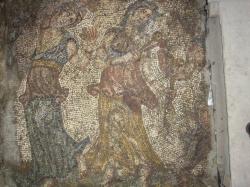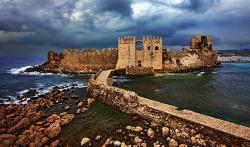05 OCTOBRE
INDI-UNI : ANTHROPOLOGIE - ARCHEOLOGIE
INSCRIPTION 2011 – 2012 COURS A DISTANCE
REGISTRATION 2011 – 2012 ONLINE COURSES
AZERBAIDJAN – Mer Caspienne - The Russian Academy of Sciences (RAS) offers Azerbaijan to conduct joint underwater archaeological work in the Caspian Sea, Director of the Archaeology and Ethnography Institute of the Azerbaijani National Academy of Sciences (ANAS) Mais Rahimov told Trend. She said Russia is very interested in carrying out underwater excavations in the Caspian Sea. It is expected that cooperation in conducting the excavations will be discussed by the leadership of RAS and ANAS President Mahmud Kerimov. Discussions may be held during the RAS leadership's visit to Baku to attend the upcoming forum on humanities. A lot of money is required for underwater archaeological excavations in the Caspian Sea, Rahimov said. According to the Institute director, there are no experts in underwater archeology in Azerbaijan to conduct excavations. Therefore, Azerbaijan may send its employees to Russia to gain experience.
http://en.trend.az/news/society/1941959.html
BULGARIE –  Stara Zagora - Bulgarian archeologists have unearthed unique mosaic in the southern municipality of Stara Zagora, the press center of the municipality announced. A team headed by Dimitar Yankov, chief curator of the Regional Museum of History in the city of Stara Zagora, held a press conference on Tuesday to brief the media about the find. The mosaic dates back to around the 3rd century and depicts a man and two women, all members of Dionysus’ entourage. “The complex figures of dancing women suggest the mosaic was done by a great master. The clothes are in five shades of blue and the red color varies from pink to dark red. The figures are very fine. One of the women holds castanets in her hands and the other one holds other music instruments. The folds of their clothes suggest their knees are bent. Their ankles are bare and their legs move. There is play of light and shade,” said Dimitar Yankov and expressed hope the team’s further excavations would reveal more figures, including the one of Dionysus, the Greek god of grape harvest, winemaking and wine. According to archaeologists the building was not a private one, but a temple to Dionysus. The building is 30 meters away from the walls of the forum of the ancient Roman city of Augusta Traiana in the center of the city of Stara Zagora.
Stara Zagora - Bulgarian archeologists have unearthed unique mosaic in the southern municipality of Stara Zagora, the press center of the municipality announced. A team headed by Dimitar Yankov, chief curator of the Regional Museum of History in the city of Stara Zagora, held a press conference on Tuesday to brief the media about the find. The mosaic dates back to around the 3rd century and depicts a man and two women, all members of Dionysus’ entourage. “The complex figures of dancing women suggest the mosaic was done by a great master. The clothes are in five shades of blue and the red color varies from pink to dark red. The figures are very fine. One of the women holds castanets in her hands and the other one holds other music instruments. The folds of their clothes suggest their knees are bent. Their ankles are bare and their legs move. There is play of light and shade,” said Dimitar Yankov and expressed hope the team’s further excavations would reveal more figures, including the one of Dionysus, the Greek god of grape harvest, winemaking and wine. According to archaeologists the building was not a private one, but a temple to Dionysus. The building is 30 meters away from the walls of the forum of the ancient Roman city of Augusta Traiana in the center of the city of Stara Zagora.
http://www.focus-fen.net/index.php?id=n260881
CHINE – Loulan - Chinese archaeologists say they've found evidence of agricultural activity in an ancient vanished city that was a pivotal stop along the famous Silk Road. Scientists from the Institute of Geology and Geophysics said remote sensing procedures, field investigations and sample testing in the area showed there were once large tracts of farmland in Loulan, an important trading city that mysteriously disappeared in the third century A.D., China's official news agency Xinhua reported Sunday. Farmland featuring regular and straight plots stretching for 200 to 1,000 yards, as well as irrigation ditches running throughout, have been found, Qin Xiaoguang, a member of the research team, said. Grain particles in the area's ground surface are very likely the remains of crop plants, Qin said. Evidence of an ancient canal measuring 10 to 20 yards wide and 5 feet deep suggest the city, which is thought to have perished in drought, was once rich in water resources, the researchers said.
http://www.upi.com/Science_News/2011/10/04/Vanished-Silk-Road-city-studied-in-China/UPI-78801317774638/#ixzz1a16bCGKe
GRECE –  Peloponnese - Fortresses – symbols of the wealth and power of the Byzantine and Venetian period and built on Greek territory from the V to the XV century to provide protection for the population – are an important part of the cultural heritage of Greece, where they are found almost everywhere. Most of them are located in the Peloponnese where – according to Dimitris Athanasoulis, director of the 25th Superintendence of Byzantine Antiquities – only in the Messinia (in the southern Peloponnese) zone there are over 50. The problem is that they are abandoned and as time goes by they are at risk of collapse, as has already happened a number of times, and many are not even able to be reached nor visited. In order to raise awareness on this cultural wealth within the country and to help save them, the 25th Superintendence in collaboration with the Patras Architects University held an international conference on ”Defensive Architecture in the Peloponnese” which – inaugurated by Culture and Tourism Minister Pavlos Geroulanos – came to an end yesterday. Taking part in the conference were 41 experts including archaeologists, architects and historians from Greece and abroad, who discussed a number of subjects concerning fortresses in the Byzantine period, defensive works in the West and its influence on the Byzantine variety. As part of these initiatives to raise awareness of this type of cultural heritage in Greece, Greece’s Central Archaeological Council has decided recently to valorise the Pylos Fortress, also known as Niocastro, which was built by the Ottomans in 1573 shorting after their defeat in the Battle of Lepanto in 1571. The city’s Archaeological Museum will soon be transferred inside of it, in which exhibitions will be held and a film will be shown with the historical reconstruction of the naval battle of Navarino.
Peloponnese - Fortresses – symbols of the wealth and power of the Byzantine and Venetian period and built on Greek territory from the V to the XV century to provide protection for the population – are an important part of the cultural heritage of Greece, where they are found almost everywhere. Most of them are located in the Peloponnese where – according to Dimitris Athanasoulis, director of the 25th Superintendence of Byzantine Antiquities – only in the Messinia (in the southern Peloponnese) zone there are over 50. The problem is that they are abandoned and as time goes by they are at risk of collapse, as has already happened a number of times, and many are not even able to be reached nor visited. In order to raise awareness on this cultural wealth within the country and to help save them, the 25th Superintendence in collaboration with the Patras Architects University held an international conference on ”Defensive Architecture in the Peloponnese” which – inaugurated by Culture and Tourism Minister Pavlos Geroulanos – came to an end yesterday. Taking part in the conference were 41 experts including archaeologists, architects and historians from Greece and abroad, who discussed a number of subjects concerning fortresses in the Byzantine period, defensive works in the West and its influence on the Byzantine variety. As part of these initiatives to raise awareness of this type of cultural heritage in Greece, Greece’s Central Archaeological Council has decided recently to valorise the Pylos Fortress, also known as Niocastro, which was built by the Ottomans in 1573 shorting after their defeat in the Battle of Lepanto in 1571. The city’s Archaeological Museum will soon be transferred inside of it, in which exhibitions will be held and a film will be shown with the historical reconstruction of the naval battle of Navarino.
http://greece.greekreporter.com/2011/10/05/historic-byzantine-and-venetian-fortresses-at-risk/
USA - Carteret County - A four-week fall expedition at the Queen Anne’s Revenge shipwreck site is under way, and the first look at the wreck site since Hurricane Irene brought good news. The hurricane swept the North Carolina coast in late August without causing major disruption to the shipwreck site, said QAR Project Director Mark Wilde-Ramsing. After the one-day dive last week to take a preliminary look at the site and begin preparations, the QAR project team kicked off the four-week expedition Monday and will be further assessing the site’s condition, stabilizing areas where it’s needed and continuing the excavation and recovery of artifacts. The excavation of artifacts will focus on a previously known scour area in the area of the vessel’s foremast and galley area. A highlight of the expedition is the planned recovery of cannon C23, one of the ship’s largest guns, at the close of the expedition. And surrounding the cannon are a kettle, wooden deadeyes, a pewter plate, cannon balls and other unidentified artifacts to be recovered. Also during the expedition, the QAR team will continue “in situ” conservation monitoring. Aluminum rods called sacrificial anodes have been attached to all but three remaining cannons to change the electrochemical process that corrodes iron in saltwater, reducing or even reversing the amount of salts absorbed by the iron objects.
http://www.jdnews.com/articles/carteret-95774-county-expedition.html
PAKISTAN - Peshawar valley - The Directorate of Archaeology and Museums (DAM), Khyber Pakhtunkhwa, in collaboration with Tourism Corporation Khyber Pakh-tunkhwa (TCKP) will hold an exhibition cum festival to celebrate 2500 years history of Peshawar valley in the last week of this month at Gor Khattri Archaeological Complex. In this exhibition history of coinage in Peshawar valley from 600 BC to modern period will be highlighted. Ancient coins from 600 BC to modern period, including Greek, Scthian, Kushan, Hindu Shahi and Mughal period would be put on display at the exhibition.
http://pakobserver.net/detailnews.asp?id=118366